Managing and Coordinating the Human Resources Function Assignment
VerifiedAdded on 2021/01/02
|16
|5660
|486
Report
AI Summary
This report delves into the critical role of the Human Resources (HR) function within organizations, examining its contribution to achieving organisational objectives. It begins by identifying examples of organisational objectives that HR delivers, highlighting the importance of HR in recruitment, training, and employee management. The report explores diverse methods of HR delivery, including the Ulrich model and the varying approaches across different sectors (private, public, SMEs, and voluntary organisations). It then analyzes change management theories and methods for evaluating the contribution of HR functions, with an emphasis on the impact of HR practices on organisational outcomes. The report also includes a discussion on the code of professional conduct and employee relations. Overall, the report underscores the strategic importance of HR in driving organizational success and adapting to evolving business environments.
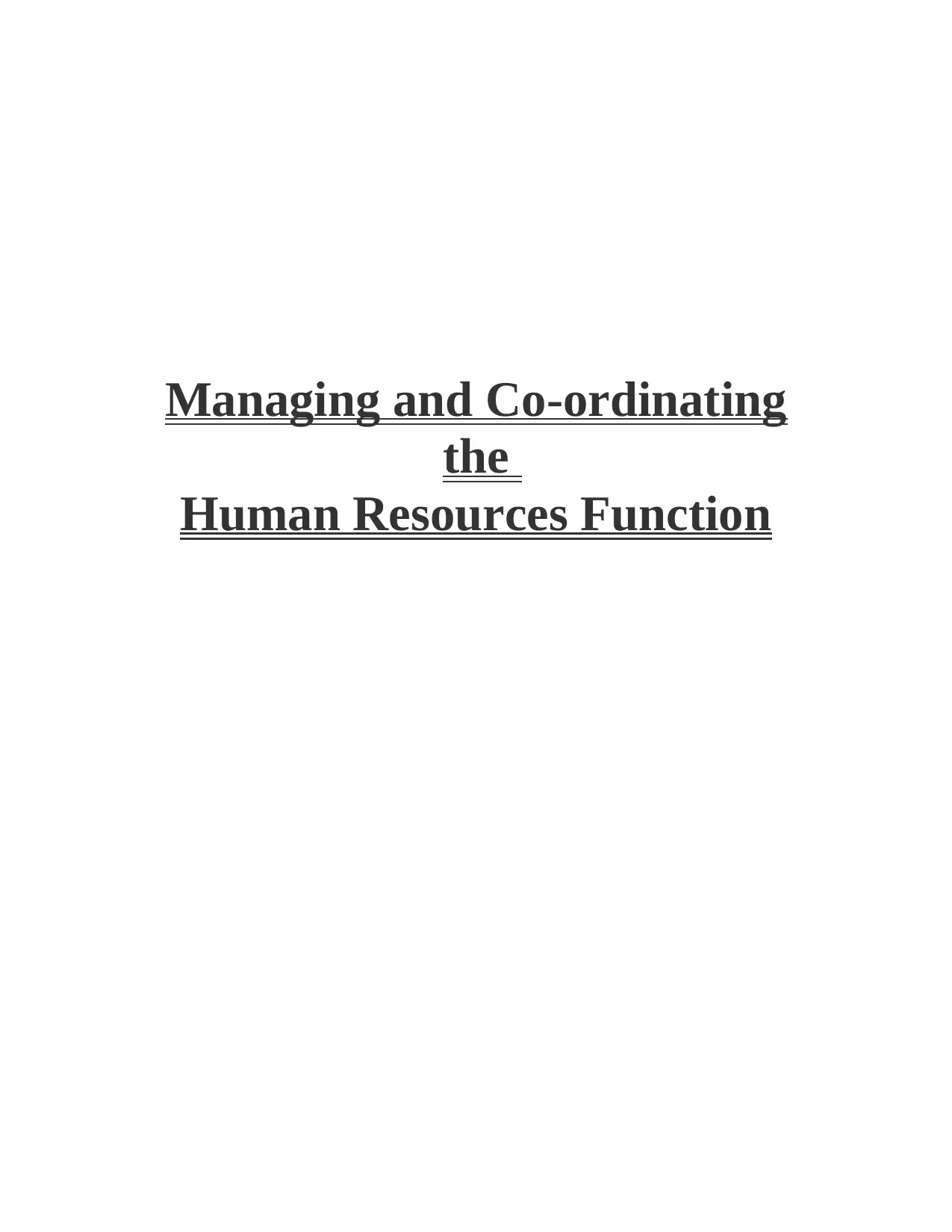
Managing and Co-ordinating
the
Human Resources Function
the
Human Resources Function
Paraphrase This Document
Need a fresh take? Get an instant paraphrase of this document with our AI Paraphraser
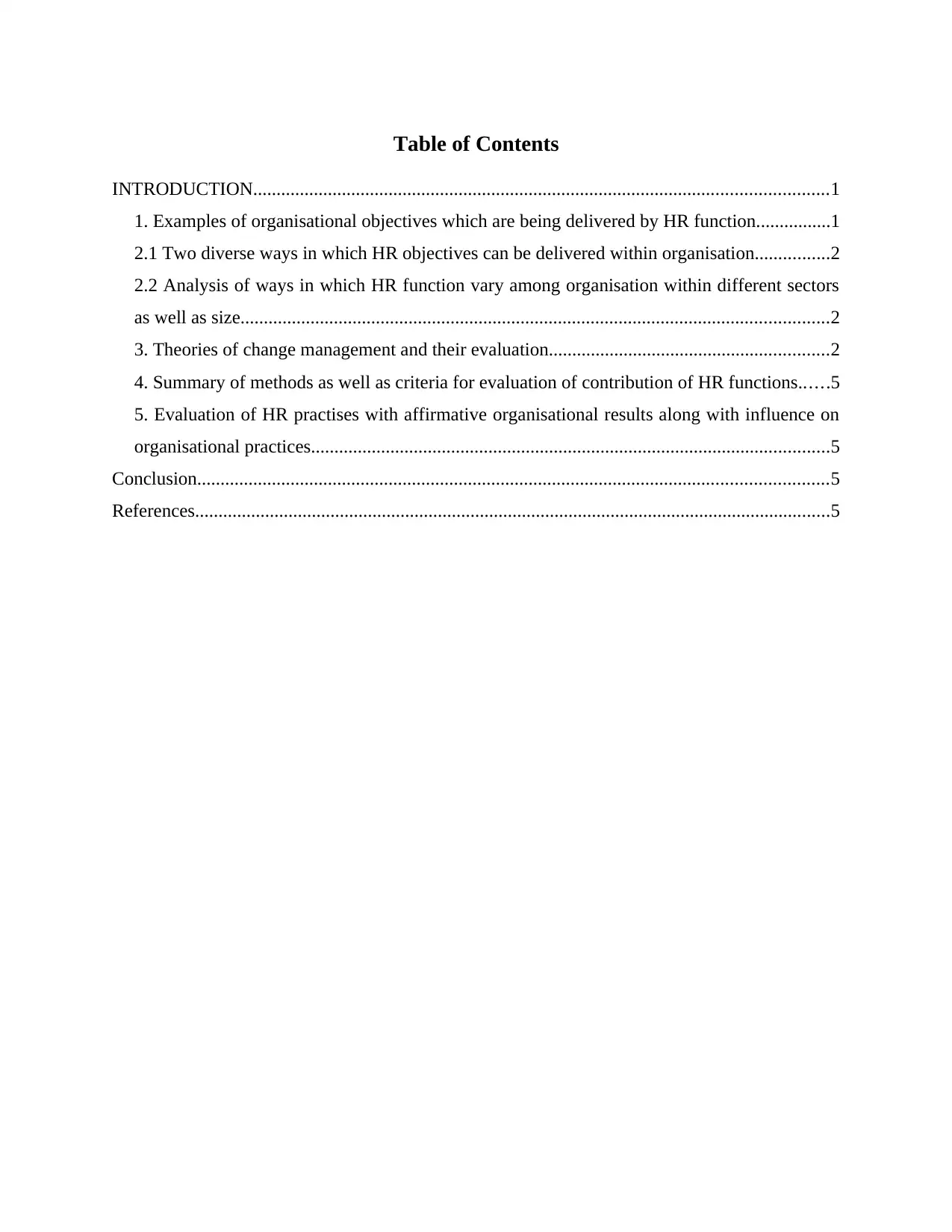
Table of Contents
INTRODUCTION...........................................................................................................................1
1. Examples of organisational objectives which are being delivered by HR function................1
2.1 Two diverse ways in which HR objectives can be delivered within organisation................2
2.2 Analysis of ways in which HR function vary among organisation within different sectors
as well as size..............................................................................................................................2
3. Theories of change management and their evaluation............................................................2
4. Summary of methods as well as criteria for evaluation of contribution of HR functions......5
5. Evaluation of HR practises with affirmative organisational results along with influence on
organisational practices...............................................................................................................5
Conclusion.......................................................................................................................................5
References........................................................................................................................................5
INTRODUCTION...........................................................................................................................1
1. Examples of organisational objectives which are being delivered by HR function................1
2.1 Two diverse ways in which HR objectives can be delivered within organisation................2
2.2 Analysis of ways in which HR function vary among organisation within different sectors
as well as size..............................................................................................................................2
3. Theories of change management and their evaluation............................................................2
4. Summary of methods as well as criteria for evaluation of contribution of HR functions......5
5. Evaluation of HR practises with affirmative organisational results along with influence on
organisational practices...............................................................................................................5
Conclusion.......................................................................................................................................5
References........................................................................................................................................5
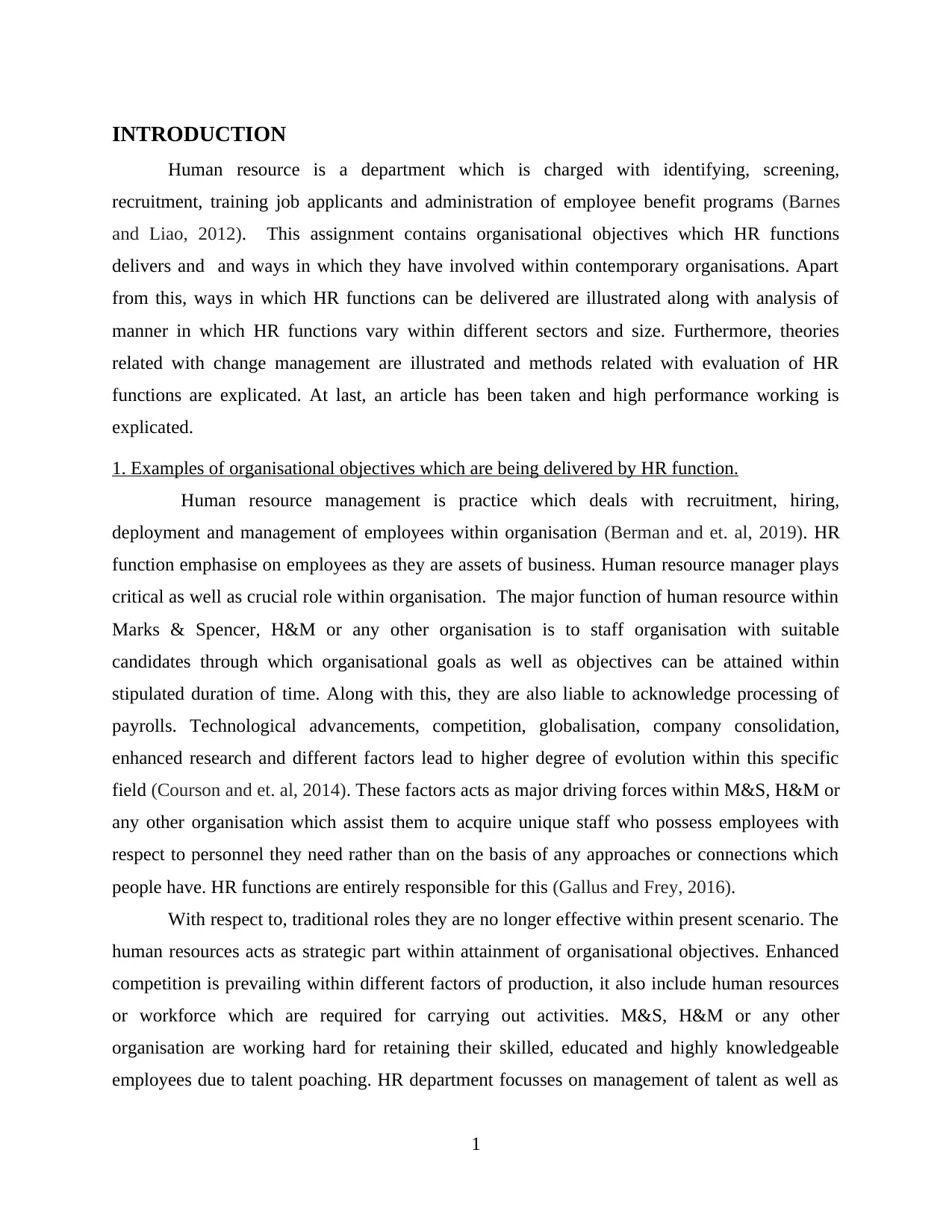
INTRODUCTION
Human resource is a department which is charged with identifying, screening,
recruitment, training job applicants and administration of employee benefit programs (Barnes
and Liao, 2012). This assignment contains organisational objectives which HR functions
delivers and and ways in which they have involved within contemporary organisations. Apart
from this, ways in which HR functions can be delivered are illustrated along with analysis of
manner in which HR functions vary within different sectors and size. Furthermore, theories
related with change management are illustrated and methods related with evaluation of HR
functions are explicated. At last, an article has been taken and high performance working is
explicated.
1. Examples of organisational objectives which are being delivered by HR function.
Human resource management is practice which deals with recruitment, hiring,
deployment and management of employees within organisation (Berman and et. al, 2019). HR
function emphasise on employees as they are assets of business. Human resource manager plays
critical as well as crucial role within organisation. The major function of human resource within
Marks & Spencer, H&M or any other organisation is to staff organisation with suitable
candidates through which organisational goals as well as objectives can be attained within
stipulated duration of time. Along with this, they are also liable to acknowledge processing of
payrolls. Technological advancements, competition, globalisation, company consolidation,
enhanced research and different factors lead to higher degree of evolution within this specific
field (Courson and et. al, 2014). These factors acts as major driving forces within M&S, H&M or
any other organisation which assist them to acquire unique staff who possess employees with
respect to personnel they need rather than on the basis of any approaches or connections which
people have. HR functions are entirely responsible for this (Gallus and Frey, 2016).
With respect to, traditional roles they are no longer effective within present scenario. The
human resources acts as strategic part within attainment of organisational objectives. Enhanced
competition is prevailing within different factors of production, it also include human resources
or workforce which are required for carrying out activities. M&S, H&M or any other
organisation are working hard for retaining their skilled, educated and highly knowledgeable
employees due to talent poaching. HR department focusses on management of talent as well as
1
Human resource is a department which is charged with identifying, screening,
recruitment, training job applicants and administration of employee benefit programs (Barnes
and Liao, 2012). This assignment contains organisational objectives which HR functions
delivers and and ways in which they have involved within contemporary organisations. Apart
from this, ways in which HR functions can be delivered are illustrated along with analysis of
manner in which HR functions vary within different sectors and size. Furthermore, theories
related with change management are illustrated and methods related with evaluation of HR
functions are explicated. At last, an article has been taken and high performance working is
explicated.
1. Examples of organisational objectives which are being delivered by HR function.
Human resource management is practice which deals with recruitment, hiring,
deployment and management of employees within organisation (Berman and et. al, 2019). HR
function emphasise on employees as they are assets of business. Human resource manager plays
critical as well as crucial role within organisation. The major function of human resource within
Marks & Spencer, H&M or any other organisation is to staff organisation with suitable
candidates through which organisational goals as well as objectives can be attained within
stipulated duration of time. Along with this, they are also liable to acknowledge processing of
payrolls. Technological advancements, competition, globalisation, company consolidation,
enhanced research and different factors lead to higher degree of evolution within this specific
field (Courson and et. al, 2014). These factors acts as major driving forces within M&S, H&M or
any other organisation which assist them to acquire unique staff who possess employees with
respect to personnel they need rather than on the basis of any approaches or connections which
people have. HR functions are entirely responsible for this (Gallus and Frey, 2016).
With respect to, traditional roles they are no longer effective within present scenario. The
human resources acts as strategic part within attainment of organisational objectives. Enhanced
competition is prevailing within different factors of production, it also include human resources
or workforce which are required for carrying out activities. M&S, H&M or any other
organisation are working hard for retaining their skilled, educated and highly knowledgeable
employees due to talent poaching. HR department focusses on management of talent as well as
1
⊘ This is a preview!⊘
Do you want full access?
Subscribe today to unlock all pages.

Trusted by 1+ million students worldwide
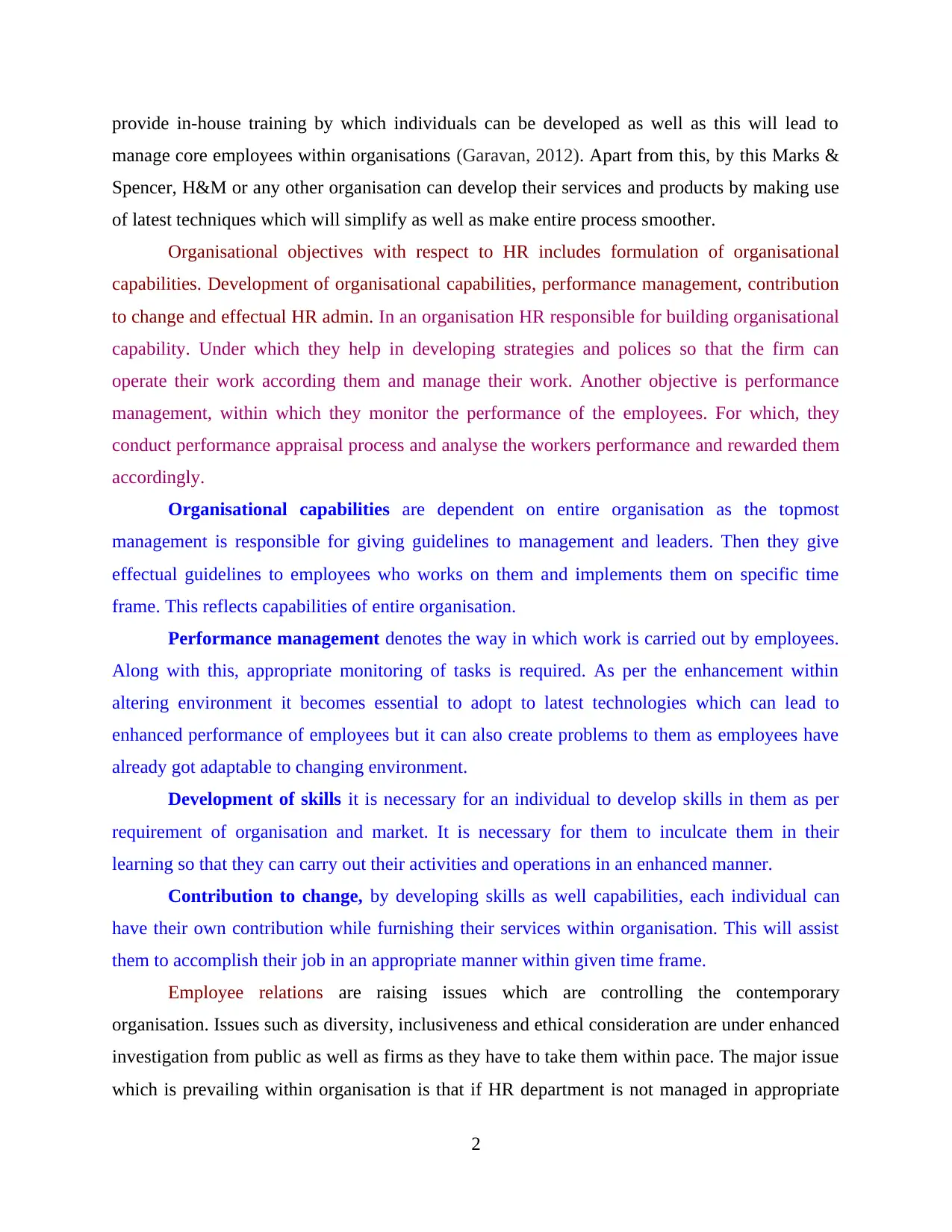
provide in-house training by which individuals can be developed as well as this will lead to
manage core employees within organisations (Garavan, 2012). Apart from this, by this Marks &
Spencer, H&M or any other organisation can develop their services and products by making use
of latest techniques which will simplify as well as make entire process smoother.
Organisational objectives with respect to HR includes formulation of organisational
capabilities. Development of organisational capabilities, performance management, contribution
to change and effectual HR admin. In an organisation HR responsible for building organisational
capability. Under which they help in developing strategies and polices so that the firm can
operate their work according them and manage their work. Another objective is performance
management, within which they monitor the performance of the employees. For which, they
conduct performance appraisal process and analyse the workers performance and rewarded them
accordingly.
Organisational capabilities are dependent on entire organisation as the topmost
management is responsible for giving guidelines to management and leaders. Then they give
effectual guidelines to employees who works on them and implements them on specific time
frame. This reflects capabilities of entire organisation.
Performance management denotes the way in which work is carried out by employees.
Along with this, appropriate monitoring of tasks is required. As per the enhancement within
altering environment it becomes essential to adopt to latest technologies which can lead to
enhanced performance of employees but it can also create problems to them as employees have
already got adaptable to changing environment.
Development of skills it is necessary for an individual to develop skills in them as per
requirement of organisation and market. It is necessary for them to inculcate them in their
learning so that they can carry out their activities and operations in an enhanced manner.
Contribution to change, by developing skills as well capabilities, each individual can
have their own contribution while furnishing their services within organisation. This will assist
them to accomplish their job in an appropriate manner within given time frame.
Employee relations are raising issues which are controlling the contemporary
organisation. Issues such as diversity, inclusiveness and ethical consideration are under enhanced
investigation from public as well as firms as they have to take them within pace. The major issue
which is prevailing within organisation is that if HR department is not managed in appropriate
2
manage core employees within organisations (Garavan, 2012). Apart from this, by this Marks &
Spencer, H&M or any other organisation can develop their services and products by making use
of latest techniques which will simplify as well as make entire process smoother.
Organisational objectives with respect to HR includes formulation of organisational
capabilities. Development of organisational capabilities, performance management, contribution
to change and effectual HR admin. In an organisation HR responsible for building organisational
capability. Under which they help in developing strategies and polices so that the firm can
operate their work according them and manage their work. Another objective is performance
management, within which they monitor the performance of the employees. For which, they
conduct performance appraisal process and analyse the workers performance and rewarded them
accordingly.
Organisational capabilities are dependent on entire organisation as the topmost
management is responsible for giving guidelines to management and leaders. Then they give
effectual guidelines to employees who works on them and implements them on specific time
frame. This reflects capabilities of entire organisation.
Performance management denotes the way in which work is carried out by employees.
Along with this, appropriate monitoring of tasks is required. As per the enhancement within
altering environment it becomes essential to adopt to latest technologies which can lead to
enhanced performance of employees but it can also create problems to them as employees have
already got adaptable to changing environment.
Development of skills it is necessary for an individual to develop skills in them as per
requirement of organisation and market. It is necessary for them to inculcate them in their
learning so that they can carry out their activities and operations in an enhanced manner.
Contribution to change, by developing skills as well capabilities, each individual can
have their own contribution while furnishing their services within organisation. This will assist
them to accomplish their job in an appropriate manner within given time frame.
Employee relations are raising issues which are controlling the contemporary
organisation. Issues such as diversity, inclusiveness and ethical consideration are under enhanced
investigation from public as well as firms as they have to take them within pace. The major issue
which is prevailing within organisation is that if HR department is not managed in appropriate
2
Paraphrase This Document
Need a fresh take? Get an instant paraphrase of this document with our AI Paraphraser
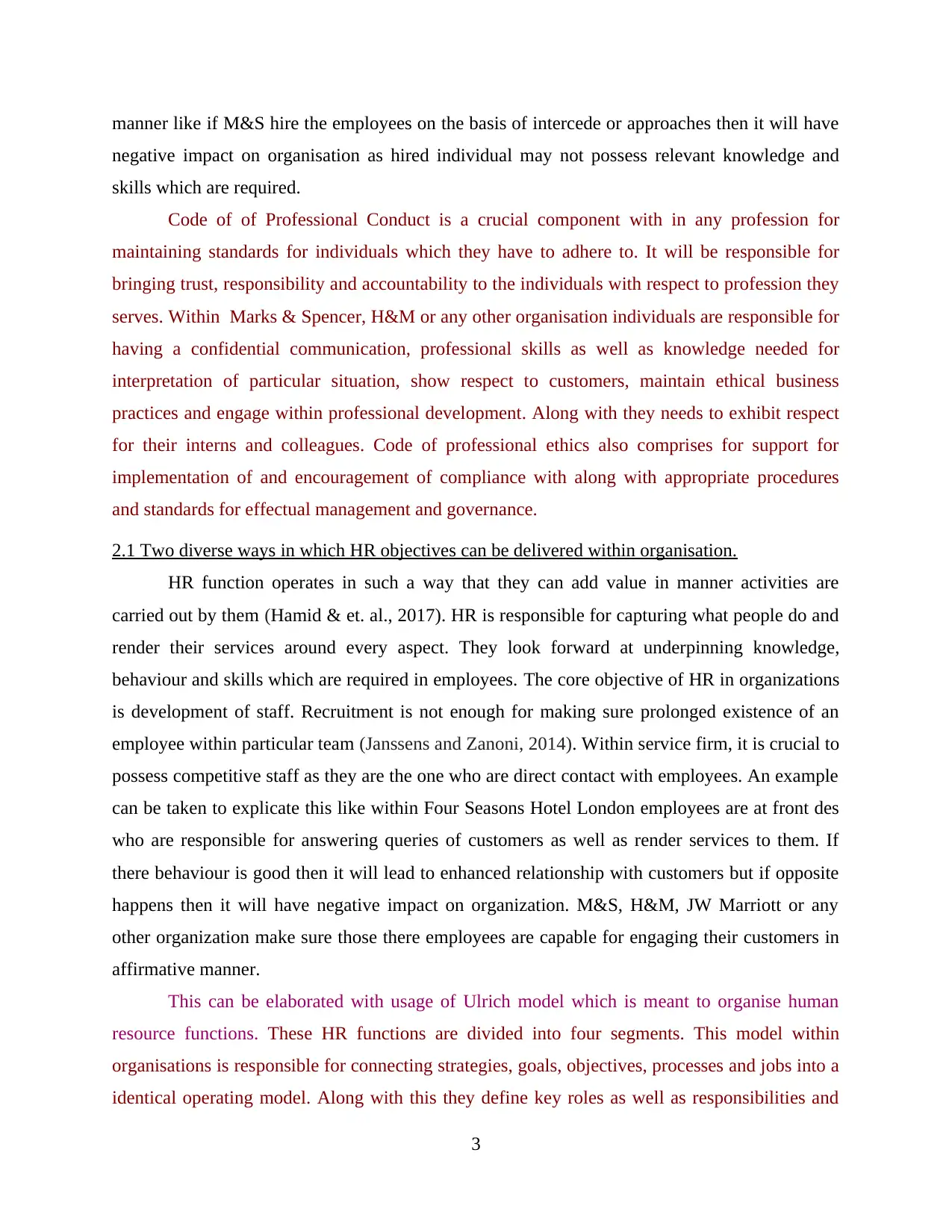
manner like if M&S hire the employees on the basis of intercede or approaches then it will have
negative impact on organisation as hired individual may not possess relevant knowledge and
skills which are required.
Code of of Professional Conduct is a crucial component with in any profession for
maintaining standards for individuals which they have to adhere to. It will be responsible for
bringing trust, responsibility and accountability to the individuals with respect to profession they
serves. Within Marks & Spencer, H&M or any other organisation individuals are responsible for
having a confidential communication, professional skills as well as knowledge needed for
interpretation of particular situation, show respect to customers, maintain ethical business
practices and engage within professional development. Along with they needs to exhibit respect
for their interns and colleagues. Code of professional ethics also comprises for support for
implementation of and encouragement of compliance with along with appropriate procedures
and standards for effectual management and governance.
2.1 Two diverse ways in which HR objectives can be delivered within organisation.
HR function operates in such a way that they can add value in manner activities are
carried out by them (Hamid & et. al., 2017). HR is responsible for capturing what people do and
render their services around every aspect. They look forward at underpinning knowledge,
behaviour and skills which are required in employees. The core objective of HR in organizations
is development of staff. Recruitment is not enough for making sure prolonged existence of an
employee within particular team (Janssens and Zanoni, 2014). Within service firm, it is crucial to
possess competitive staff as they are the one who are direct contact with employees. An example
can be taken to explicate this like within Four Seasons Hotel London employees are at front des
who are responsible for answering queries of customers as well as render services to them. If
there behaviour is good then it will lead to enhanced relationship with customers but if opposite
happens then it will have negative impact on organization. M&S, H&M, JW Marriott or any
other organization make sure those there employees are capable for engaging their customers in
affirmative manner.
This can be elaborated with usage of Ulrich model which is meant to organise human
resource functions. These HR functions are divided into four segments. This model within
organisations is responsible for connecting strategies, goals, objectives, processes and jobs into a
identical operating model. Along with this they define key roles as well as responsibilities and
3
negative impact on organisation as hired individual may not possess relevant knowledge and
skills which are required.
Code of of Professional Conduct is a crucial component with in any profession for
maintaining standards for individuals which they have to adhere to. It will be responsible for
bringing trust, responsibility and accountability to the individuals with respect to profession they
serves. Within Marks & Spencer, H&M or any other organisation individuals are responsible for
having a confidential communication, professional skills as well as knowledge needed for
interpretation of particular situation, show respect to customers, maintain ethical business
practices and engage within professional development. Along with they needs to exhibit respect
for their interns and colleagues. Code of professional ethics also comprises for support for
implementation of and encouragement of compliance with along with appropriate procedures
and standards for effectual management and governance.
2.1 Two diverse ways in which HR objectives can be delivered within organisation.
HR function operates in such a way that they can add value in manner activities are
carried out by them (Hamid & et. al., 2017). HR is responsible for capturing what people do and
render their services around every aspect. They look forward at underpinning knowledge,
behaviour and skills which are required in employees. The core objective of HR in organizations
is development of staff. Recruitment is not enough for making sure prolonged existence of an
employee within particular team (Janssens and Zanoni, 2014). Within service firm, it is crucial to
possess competitive staff as they are the one who are direct contact with employees. An example
can be taken to explicate this like within Four Seasons Hotel London employees are at front des
who are responsible for answering queries of customers as well as render services to them. If
there behaviour is good then it will lead to enhanced relationship with customers but if opposite
happens then it will have negative impact on organization. M&S, H&M, JW Marriott or any
other organization make sure those there employees are capable for engaging their customers in
affirmative manner.
This can be elaborated with usage of Ulrich model which is meant to organise human
resource functions. These HR functions are divided into four segments. This model within
organisations is responsible for connecting strategies, goals, objectives, processes and jobs into a
identical operating model. Along with this they define key roles as well as responsibilities and
3
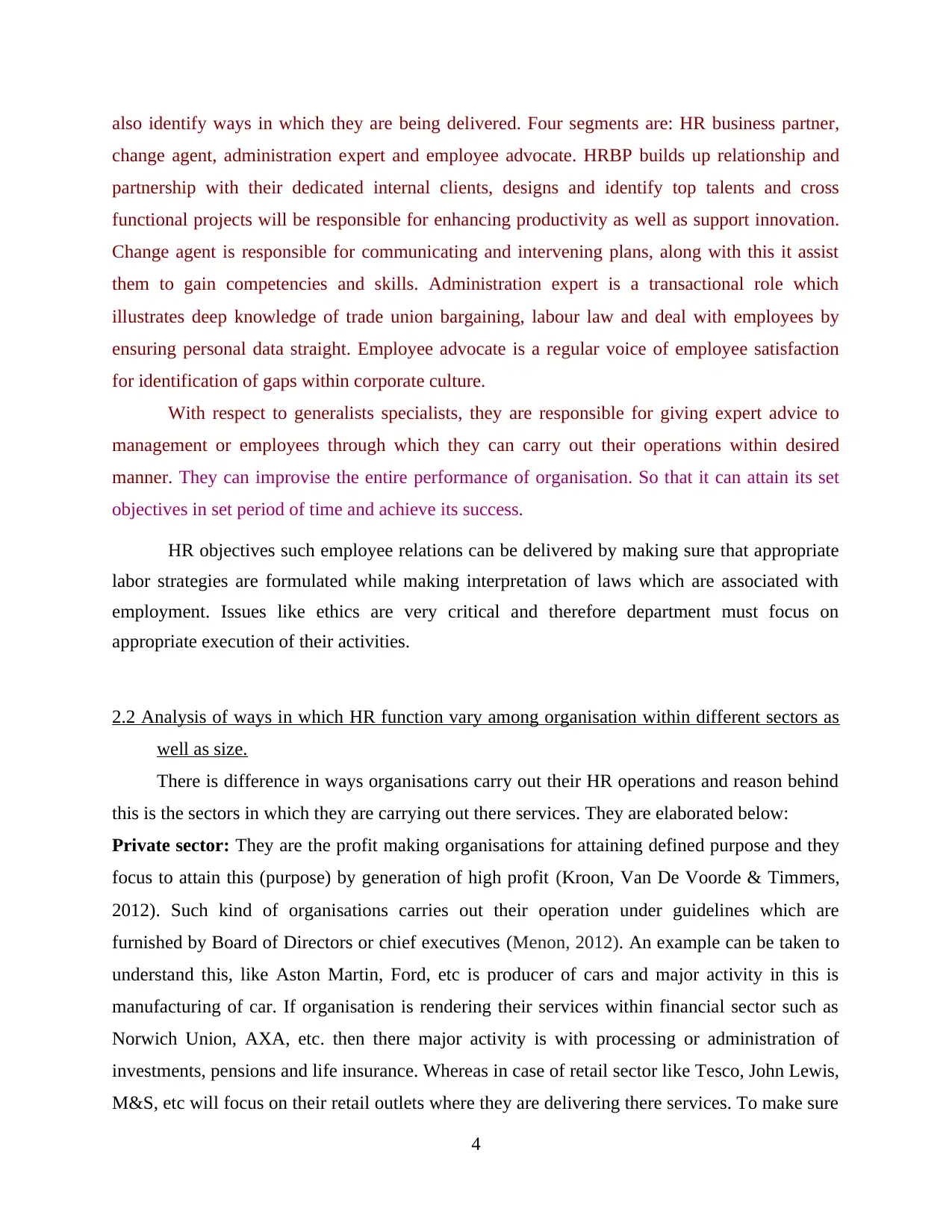
also identify ways in which they are being delivered. Four segments are: HR business partner,
change agent, administration expert and employee advocate. HRBP builds up relationship and
partnership with their dedicated internal clients, designs and identify top talents and cross
functional projects will be responsible for enhancing productivity as well as support innovation.
Change agent is responsible for communicating and intervening plans, along with this it assist
them to gain competencies and skills. Administration expert is a transactional role which
illustrates deep knowledge of trade union bargaining, labour law and deal with employees by
ensuring personal data straight. Employee advocate is a regular voice of employee satisfaction
for identification of gaps within corporate culture.
With respect to generalists specialists, they are responsible for giving expert advice to
management or employees through which they can carry out their operations within desired
manner. They can improvise the entire performance of organisation. So that it can attain its set
objectives in set period of time and achieve its success.
HR objectives such employee relations can be delivered by making sure that appropriate
labor strategies are formulated while making interpretation of laws which are associated with
employment. Issues like ethics are very critical and therefore department must focus on
appropriate execution of their activities.
2.2 Analysis of ways in which HR function vary among organisation within different sectors as
well as size.
There is difference in ways organisations carry out their HR operations and reason behind
this is the sectors in which they are carrying out there services. They are elaborated below:
Private sector: They are the profit making organisations for attaining defined purpose and they
focus to attain this (purpose) by generation of high profit (Kroon, Van De Voorde & Timmers,
2012). Such kind of organisations carries out their operation under guidelines which are
furnished by Board of Directors or chief executives (Menon, 2012). An example can be taken to
understand this, like Aston Martin, Ford, etc is producer of cars and major activity in this is
manufacturing of car. If organisation is rendering their services within financial sector such as
Norwich Union, AXA, etc. then there major activity is with processing or administration of
investments, pensions and life insurance. Whereas in case of retail sector like Tesco, John Lewis,
M&S, etc will focus on their retail outlets where they are delivering there services. To make sure
4
change agent, administration expert and employee advocate. HRBP builds up relationship and
partnership with their dedicated internal clients, designs and identify top talents and cross
functional projects will be responsible for enhancing productivity as well as support innovation.
Change agent is responsible for communicating and intervening plans, along with this it assist
them to gain competencies and skills. Administration expert is a transactional role which
illustrates deep knowledge of trade union bargaining, labour law and deal with employees by
ensuring personal data straight. Employee advocate is a regular voice of employee satisfaction
for identification of gaps within corporate culture.
With respect to generalists specialists, they are responsible for giving expert advice to
management or employees through which they can carry out their operations within desired
manner. They can improvise the entire performance of organisation. So that it can attain its set
objectives in set period of time and achieve its success.
HR objectives such employee relations can be delivered by making sure that appropriate
labor strategies are formulated while making interpretation of laws which are associated with
employment. Issues like ethics are very critical and therefore department must focus on
appropriate execution of their activities.
2.2 Analysis of ways in which HR function vary among organisation within different sectors as
well as size.
There is difference in ways organisations carry out their HR operations and reason behind
this is the sectors in which they are carrying out there services. They are elaborated below:
Private sector: They are the profit making organisations for attaining defined purpose and they
focus to attain this (purpose) by generation of high profit (Kroon, Van De Voorde & Timmers,
2012). Such kind of organisations carries out their operation under guidelines which are
furnished by Board of Directors or chief executives (Menon, 2012). An example can be taken to
understand this, like Aston Martin, Ford, etc is producer of cars and major activity in this is
manufacturing of car. If organisation is rendering their services within financial sector such as
Norwich Union, AXA, etc. then there major activity is with processing or administration of
investments, pensions and life insurance. Whereas in case of retail sector like Tesco, John Lewis,
M&S, etc will focus on their retail outlets where they are delivering there services. To make sure
4
⊘ This is a preview!⊘
Do you want full access?
Subscribe today to unlock all pages.

Trusted by 1+ million students worldwide
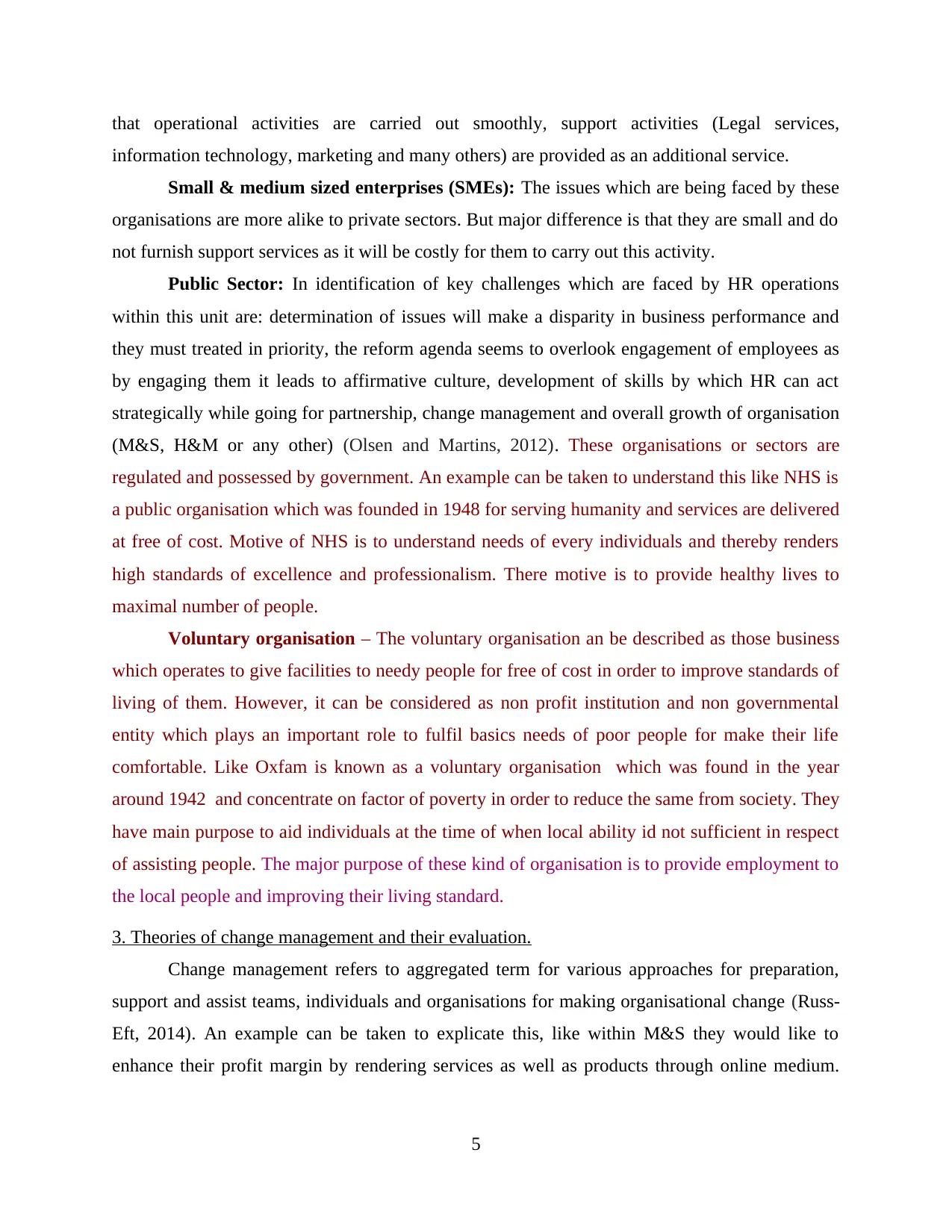
that operational activities are carried out smoothly, support activities (Legal services,
information technology, marketing and many others) are provided as an additional service.
Small & medium sized enterprises (SMEs): The issues which are being faced by these
organisations are more alike to private sectors. But major difference is that they are small and do
not furnish support services as it will be costly for them to carry out this activity.
Public Sector: In identification of key challenges which are faced by HR operations
within this unit are: determination of issues will make a disparity in business performance and
they must treated in priority, the reform agenda seems to overlook engagement of employees as
by engaging them it leads to affirmative culture, development of skills by which HR can act
strategically while going for partnership, change management and overall growth of organisation
(M&S, H&M or any other) (Olsen and Martins, 2012). These organisations or sectors are
regulated and possessed by government. An example can be taken to understand this like NHS is
a public organisation which was founded in 1948 for serving humanity and services are delivered
at free of cost. Motive of NHS is to understand needs of every individuals and thereby renders
high standards of excellence and professionalism. There motive is to provide healthy lives to
maximal number of people.
Voluntary organisation – The voluntary organisation an be described as those business
which operates to give facilities to needy people for free of cost in order to improve standards of
living of them. However, it can be considered as non profit institution and non governmental
entity which plays an important role to fulfil basics needs of poor people for make their life
comfortable. Like Oxfam is known as a voluntary organisation which was found in the year
around 1942 and concentrate on factor of poverty in order to reduce the same from society. They
have main purpose to aid individuals at the time of when local ability id not sufficient in respect
of assisting people. The major purpose of these kind of organisation is to provide employment to
the local people and improving their living standard.
3. Theories of change management and their evaluation.
Change management refers to aggregated term for various approaches for preparation,
support and assist teams, individuals and organisations for making organisational change (Russ-
Eft, 2014). An example can be taken to explicate this, like within M&S they would like to
enhance their profit margin by rendering services as well as products through online medium.
5
information technology, marketing and many others) are provided as an additional service.
Small & medium sized enterprises (SMEs): The issues which are being faced by these
organisations are more alike to private sectors. But major difference is that they are small and do
not furnish support services as it will be costly for them to carry out this activity.
Public Sector: In identification of key challenges which are faced by HR operations
within this unit are: determination of issues will make a disparity in business performance and
they must treated in priority, the reform agenda seems to overlook engagement of employees as
by engaging them it leads to affirmative culture, development of skills by which HR can act
strategically while going for partnership, change management and overall growth of organisation
(M&S, H&M or any other) (Olsen and Martins, 2012). These organisations or sectors are
regulated and possessed by government. An example can be taken to understand this like NHS is
a public organisation which was founded in 1948 for serving humanity and services are delivered
at free of cost. Motive of NHS is to understand needs of every individuals and thereby renders
high standards of excellence and professionalism. There motive is to provide healthy lives to
maximal number of people.
Voluntary organisation – The voluntary organisation an be described as those business
which operates to give facilities to needy people for free of cost in order to improve standards of
living of them. However, it can be considered as non profit institution and non governmental
entity which plays an important role to fulfil basics needs of poor people for make their life
comfortable. Like Oxfam is known as a voluntary organisation which was found in the year
around 1942 and concentrate on factor of poverty in order to reduce the same from society. They
have main purpose to aid individuals at the time of when local ability id not sufficient in respect
of assisting people. The major purpose of these kind of organisation is to provide employment to
the local people and improving their living standard.
3. Theories of change management and their evaluation.
Change management refers to aggregated term for various approaches for preparation,
support and assist teams, individuals and organisations for making organisational change (Russ-
Eft, 2014). An example can be taken to explicate this, like within M&S they would like to
enhance their profit margin by rendering services as well as products through online medium.
5
Paraphrase This Document
Need a fresh take? Get an instant paraphrase of this document with our AI Paraphraser
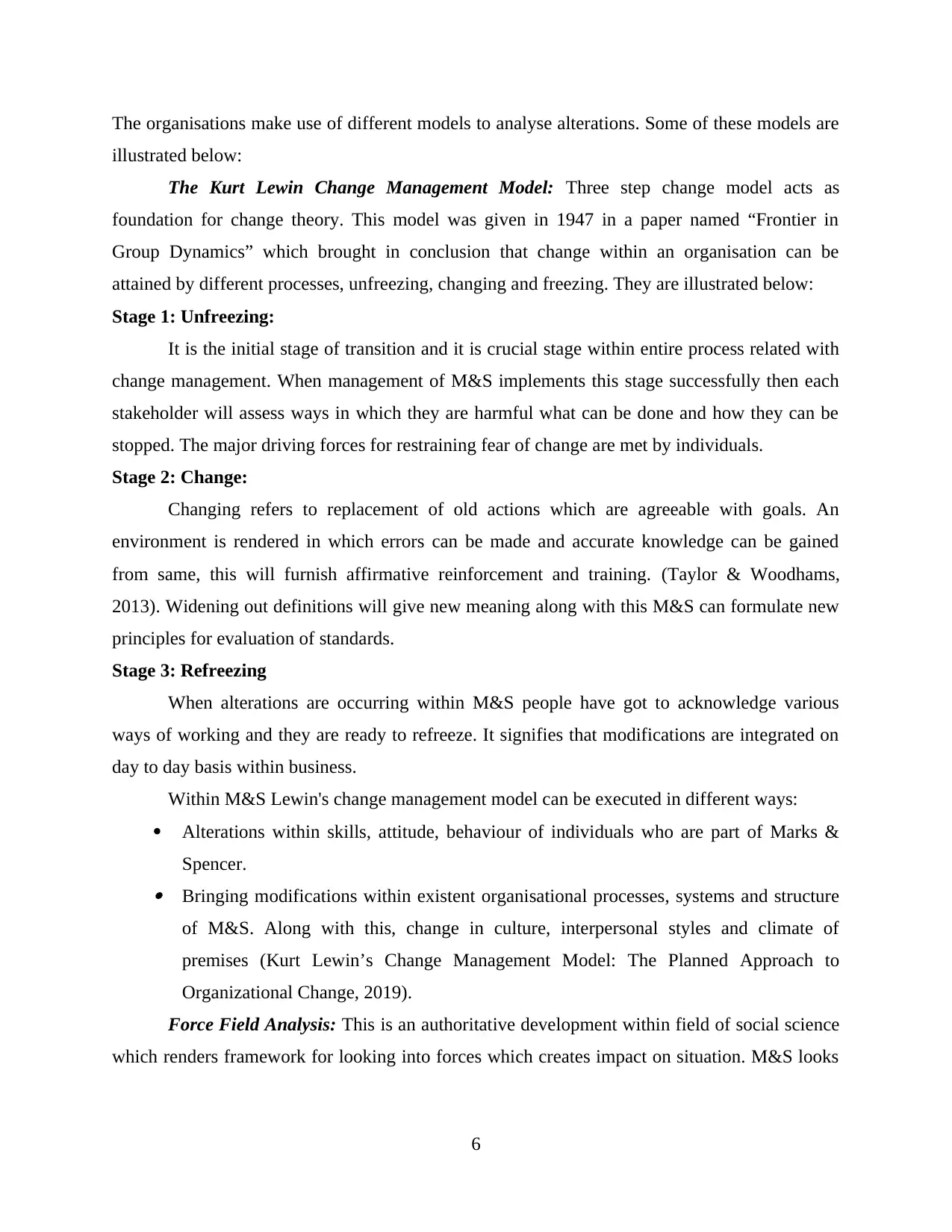
The organisations make use of different models to analyse alterations. Some of these models are
illustrated below:
The Kurt Lewin Change Management Model: Three step change model acts as
foundation for change theory. This model was given in 1947 in a paper named “Frontier in
Group Dynamics” which brought in conclusion that change within an organisation can be
attained by different processes, unfreezing, changing and freezing. They are illustrated below:
Stage 1: Unfreezing:
It is the initial stage of transition and it is crucial stage within entire process related with
change management. When management of M&S implements this stage successfully then each
stakeholder will assess ways in which they are harmful what can be done and how they can be
stopped. The major driving forces for restraining fear of change are met by individuals.
Stage 2: Change:
Changing refers to replacement of old actions which are agreeable with goals. An
environment is rendered in which errors can be made and accurate knowledge can be gained
from same, this will furnish affirmative reinforcement and training. (Taylor & Woodhams,
2013). Widening out definitions will give new meaning along with this M&S can formulate new
principles for evaluation of standards.
Stage 3: Refreezing
When alterations are occurring within M&S people have got to acknowledge various
ways of working and they are ready to refreeze. It signifies that modifications are integrated on
day to day basis within business.
Within M&S Lewin's change management model can be executed in different ways:
Alterations within skills, attitude, behaviour of individuals who are part of Marks &
Spencer. Bringing modifications within existent organisational processes, systems and structure
of M&S. Along with this, change in culture, interpersonal styles and climate of
premises (Kurt Lewin’s Change Management Model: The Planned Approach to
Organizational Change, 2019).
Force Field Analysis: This is an authoritative development within field of social science
which renders framework for looking into forces which creates impact on situation. M&S looks
6
illustrated below:
The Kurt Lewin Change Management Model: Three step change model acts as
foundation for change theory. This model was given in 1947 in a paper named “Frontier in
Group Dynamics” which brought in conclusion that change within an organisation can be
attained by different processes, unfreezing, changing and freezing. They are illustrated below:
Stage 1: Unfreezing:
It is the initial stage of transition and it is crucial stage within entire process related with
change management. When management of M&S implements this stage successfully then each
stakeholder will assess ways in which they are harmful what can be done and how they can be
stopped. The major driving forces for restraining fear of change are met by individuals.
Stage 2: Change:
Changing refers to replacement of old actions which are agreeable with goals. An
environment is rendered in which errors can be made and accurate knowledge can be gained
from same, this will furnish affirmative reinforcement and training. (Taylor & Woodhams,
2013). Widening out definitions will give new meaning along with this M&S can formulate new
principles for evaluation of standards.
Stage 3: Refreezing
When alterations are occurring within M&S people have got to acknowledge various
ways of working and they are ready to refreeze. It signifies that modifications are integrated on
day to day basis within business.
Within M&S Lewin's change management model can be executed in different ways:
Alterations within skills, attitude, behaviour of individuals who are part of Marks &
Spencer. Bringing modifications within existent organisational processes, systems and structure
of M&S. Along with this, change in culture, interpersonal styles and climate of
premises (Kurt Lewin’s Change Management Model: The Planned Approach to
Organizational Change, 2019).
Force Field Analysis: This is an authoritative development within field of social science
which renders framework for looking into forces which creates impact on situation. M&S looks
6
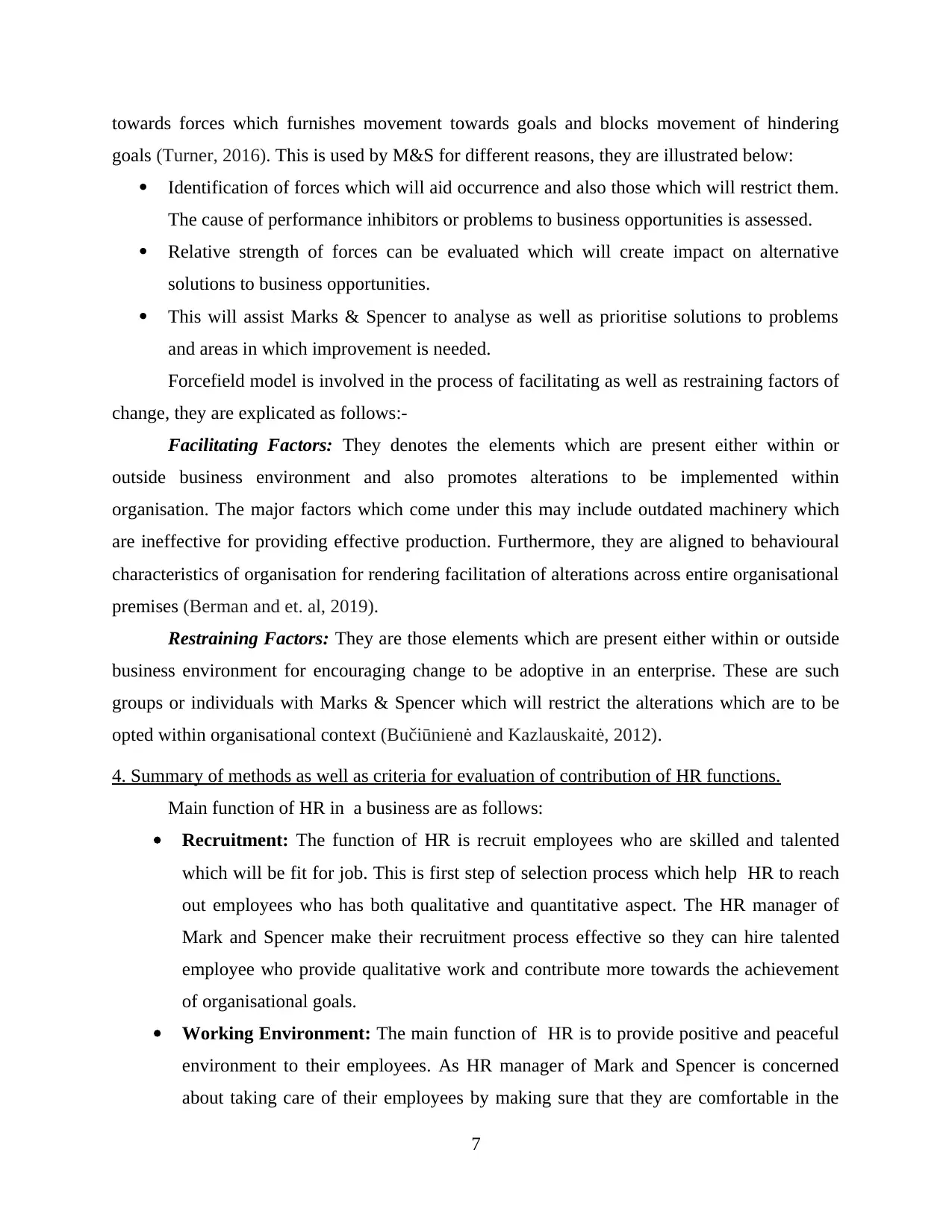
towards forces which furnishes movement towards goals and blocks movement of hindering
goals (Turner, 2016). This is used by M&S for different reasons, they are illustrated below:
Identification of forces which will aid occurrence and also those which will restrict them.
The cause of performance inhibitors or problems to business opportunities is assessed.
Relative strength of forces can be evaluated which will create impact on alternative
solutions to business opportunities.
This will assist Marks & Spencer to analyse as well as prioritise solutions to problems
and areas in which improvement is needed.
Forcefield model is involved in the process of facilitating as well as restraining factors of
change, they are explicated as follows:-
Facilitating Factors: They denotes the elements which are present either within or
outside business environment and also promotes alterations to be implemented within
organisation. The major factors which come under this may include outdated machinery which
are ineffective for providing effective production. Furthermore, they are aligned to behavioural
characteristics of organisation for rendering facilitation of alterations across entire organisational
premises (Berman and et. al, 2019).
Restraining Factors: They are those elements which are present either within or outside
business environment for encouraging change to be adoptive in an enterprise. These are such
groups or individuals with Marks & Spencer which will restrict the alterations which are to be
opted within organisational context (Bučiūnienė and Kazlauskaitė, 2012).
4. Summary of methods as well as criteria for evaluation of contribution of HR functions.
Main function of HR in a business are as follows:
Recruitment: The function of HR is recruit employees who are skilled and talented
which will be fit for job. This is first step of selection process which help HR to reach
out employees who has both qualitative and quantitative aspect. The HR manager of
Mark and Spencer make their recruitment process effective so they can hire talented
employee who provide qualitative work and contribute more towards the achievement
of organisational goals.
Working Environment: The main function of HR is to provide positive and peaceful
environment to their employees. As HR manager of Mark and Spencer is concerned
about taking care of their employees by making sure that they are comfortable in the
7
goals (Turner, 2016). This is used by M&S for different reasons, they are illustrated below:
Identification of forces which will aid occurrence and also those which will restrict them.
The cause of performance inhibitors or problems to business opportunities is assessed.
Relative strength of forces can be evaluated which will create impact on alternative
solutions to business opportunities.
This will assist Marks & Spencer to analyse as well as prioritise solutions to problems
and areas in which improvement is needed.
Forcefield model is involved in the process of facilitating as well as restraining factors of
change, they are explicated as follows:-
Facilitating Factors: They denotes the elements which are present either within or
outside business environment and also promotes alterations to be implemented within
organisation. The major factors which come under this may include outdated machinery which
are ineffective for providing effective production. Furthermore, they are aligned to behavioural
characteristics of organisation for rendering facilitation of alterations across entire organisational
premises (Berman and et. al, 2019).
Restraining Factors: They are those elements which are present either within or outside
business environment for encouraging change to be adoptive in an enterprise. These are such
groups or individuals with Marks & Spencer which will restrict the alterations which are to be
opted within organisational context (Bučiūnienė and Kazlauskaitė, 2012).
4. Summary of methods as well as criteria for evaluation of contribution of HR functions.
Main function of HR in a business are as follows:
Recruitment: The function of HR is recruit employees who are skilled and talented
which will be fit for job. This is first step of selection process which help HR to reach
out employees who has both qualitative and quantitative aspect. The HR manager of
Mark and Spencer make their recruitment process effective so they can hire talented
employee who provide qualitative work and contribute more towards the achievement
of organisational goals.
Working Environment: The main function of HR is to provide positive and peaceful
environment to their employees. As HR manager of Mark and Spencer is concerned
about taking care of their employees by making sure that they are comfortable in the
7
⊘ This is a preview!⊘
Do you want full access?
Subscribe today to unlock all pages.

Trusted by 1+ million students worldwide
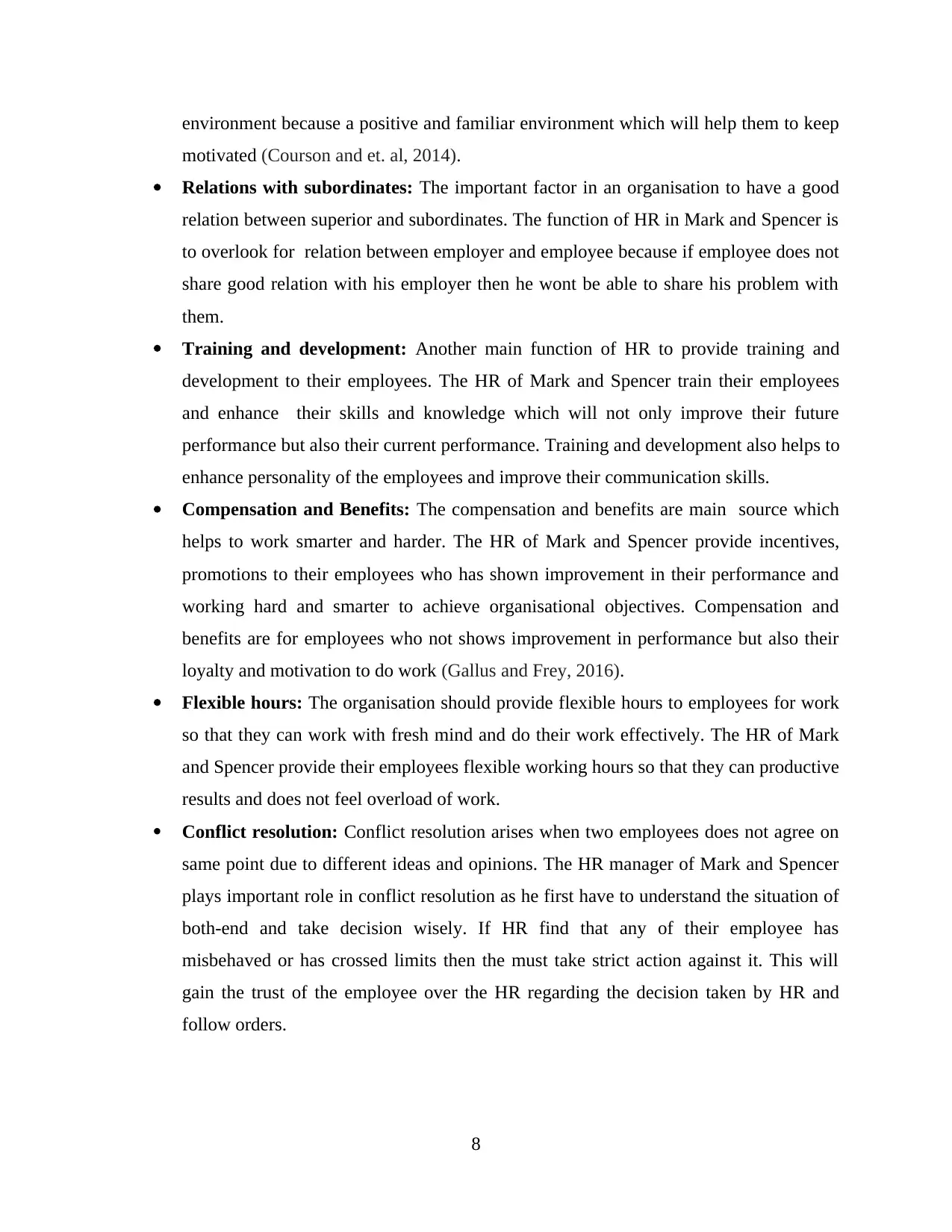
environment because a positive and familiar environment which will help them to keep
motivated (Courson and et. al, 2014).
Relations with subordinates: The important factor in an organisation to have a good
relation between superior and subordinates. The function of HR in Mark and Spencer is
to overlook for relation between employer and employee because if employee does not
share good relation with his employer then he wont be able to share his problem with
them.
Training and development: Another main function of HR to provide training and
development to their employees. The HR of Mark and Spencer train their employees
and enhance their skills and knowledge which will not only improve their future
performance but also their current performance. Training and development also helps to
enhance personality of the employees and improve their communication skills.
Compensation and Benefits: The compensation and benefits are main source which
helps to work smarter and harder. The HR of Mark and Spencer provide incentives,
promotions to their employees who has shown improvement in their performance and
working hard and smarter to achieve organisational objectives. Compensation and
benefits are for employees who not shows improvement in performance but also their
loyalty and motivation to do work (Gallus and Frey, 2016).
Flexible hours: The organisation should provide flexible hours to employees for work
so that they can work with fresh mind and do their work effectively. The HR of Mark
and Spencer provide their employees flexible working hours so that they can productive
results and does not feel overload of work.
Conflict resolution: Conflict resolution arises when two employees does not agree on
same point due to different ideas and opinions. The HR manager of Mark and Spencer
plays important role in conflict resolution as he first have to understand the situation of
both-end and take decision wisely. If HR find that any of their employee has
misbehaved or has crossed limits then the must take strict action against it. This will
gain the trust of the employee over the HR regarding the decision taken by HR and
follow orders.
8
motivated (Courson and et. al, 2014).
Relations with subordinates: The important factor in an organisation to have a good
relation between superior and subordinates. The function of HR in Mark and Spencer is
to overlook for relation between employer and employee because if employee does not
share good relation with his employer then he wont be able to share his problem with
them.
Training and development: Another main function of HR to provide training and
development to their employees. The HR of Mark and Spencer train their employees
and enhance their skills and knowledge which will not only improve their future
performance but also their current performance. Training and development also helps to
enhance personality of the employees and improve their communication skills.
Compensation and Benefits: The compensation and benefits are main source which
helps to work smarter and harder. The HR of Mark and Spencer provide incentives,
promotions to their employees who has shown improvement in their performance and
working hard and smarter to achieve organisational objectives. Compensation and
benefits are for employees who not shows improvement in performance but also their
loyalty and motivation to do work (Gallus and Frey, 2016).
Flexible hours: The organisation should provide flexible hours to employees for work
so that they can work with fresh mind and do their work effectively. The HR of Mark
and Spencer provide their employees flexible working hours so that they can productive
results and does not feel overload of work.
Conflict resolution: Conflict resolution arises when two employees does not agree on
same point due to different ideas and opinions. The HR manager of Mark and Spencer
plays important role in conflict resolution as he first have to understand the situation of
both-end and take decision wisely. If HR find that any of their employee has
misbehaved or has crossed limits then the must take strict action against it. This will
gain the trust of the employee over the HR regarding the decision taken by HR and
follow orders.
8
Paraphrase This Document
Need a fresh take? Get an instant paraphrase of this document with our AI Paraphraser
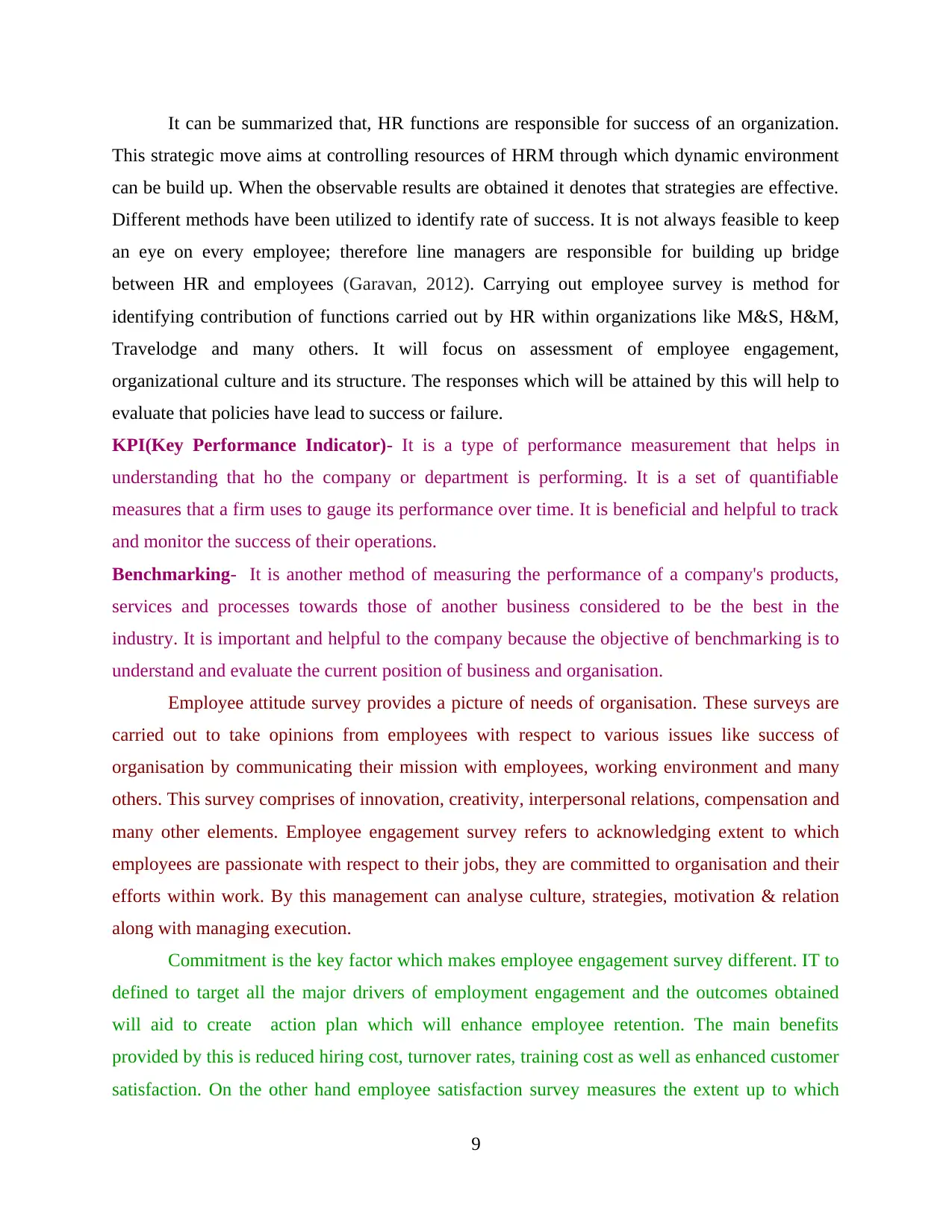
It can be summarized that, HR functions are responsible for success of an organization.
This strategic move aims at controlling resources of HRM through which dynamic environment
can be build up. When the observable results are obtained it denotes that strategies are effective.
Different methods have been utilized to identify rate of success. It is not always feasible to keep
an eye on every employee; therefore line managers are responsible for building up bridge
between HR and employees (Garavan, 2012). Carrying out employee survey is method for
identifying contribution of functions carried out by HR within organizations like M&S, H&M,
Travelodge and many others. It will focus on assessment of employee engagement,
organizational culture and its structure. The responses which will be attained by this will help to
evaluate that policies have lead to success or failure.
KPI(Key Performance Indicator)- It is a type of performance measurement that helps in
understanding that ho the company or department is performing. It is a set of quantifiable
measures that a firm uses to gauge its performance over time. It is beneficial and helpful to track
and monitor the success of their operations.
Benchmarking- It is another method of measuring the performance of a company's products,
services and processes towards those of another business considered to be the best in the
industry. It is important and helpful to the company because the objective of benchmarking is to
understand and evaluate the current position of business and organisation.
Employee attitude survey provides a picture of needs of organisation. These surveys are
carried out to take opinions from employees with respect to various issues like success of
organisation by communicating their mission with employees, working environment and many
others. This survey comprises of innovation, creativity, interpersonal relations, compensation and
many other elements. Employee engagement survey refers to acknowledging extent to which
employees are passionate with respect to their jobs, they are committed to organisation and their
efforts within work. By this management can analyse culture, strategies, motivation & relation
along with managing execution.
Commitment is the key factor which makes employee engagement survey different. IT to
defined to target all the major drivers of employment engagement and the outcomes obtained
will aid to create action plan which will enhance employee retention. The main benefits
provided by this is reduced hiring cost, turnover rates, training cost as well as enhanced customer
satisfaction. On the other hand employee satisfaction survey measures the extent up to which
9
This strategic move aims at controlling resources of HRM through which dynamic environment
can be build up. When the observable results are obtained it denotes that strategies are effective.
Different methods have been utilized to identify rate of success. It is not always feasible to keep
an eye on every employee; therefore line managers are responsible for building up bridge
between HR and employees (Garavan, 2012). Carrying out employee survey is method for
identifying contribution of functions carried out by HR within organizations like M&S, H&M,
Travelodge and many others. It will focus on assessment of employee engagement,
organizational culture and its structure. The responses which will be attained by this will help to
evaluate that policies have lead to success or failure.
KPI(Key Performance Indicator)- It is a type of performance measurement that helps in
understanding that ho the company or department is performing. It is a set of quantifiable
measures that a firm uses to gauge its performance over time. It is beneficial and helpful to track
and monitor the success of their operations.
Benchmarking- It is another method of measuring the performance of a company's products,
services and processes towards those of another business considered to be the best in the
industry. It is important and helpful to the company because the objective of benchmarking is to
understand and evaluate the current position of business and organisation.
Employee attitude survey provides a picture of needs of organisation. These surveys are
carried out to take opinions from employees with respect to various issues like success of
organisation by communicating their mission with employees, working environment and many
others. This survey comprises of innovation, creativity, interpersonal relations, compensation and
many other elements. Employee engagement survey refers to acknowledging extent to which
employees are passionate with respect to their jobs, they are committed to organisation and their
efforts within work. By this management can analyse culture, strategies, motivation & relation
along with managing execution.
Commitment is the key factor which makes employee engagement survey different. IT to
defined to target all the major drivers of employment engagement and the outcomes obtained
will aid to create action plan which will enhance employee retention. The main benefits
provided by this is reduced hiring cost, turnover rates, training cost as well as enhanced customer
satisfaction. On the other hand employee satisfaction survey measures the extent up to which
9
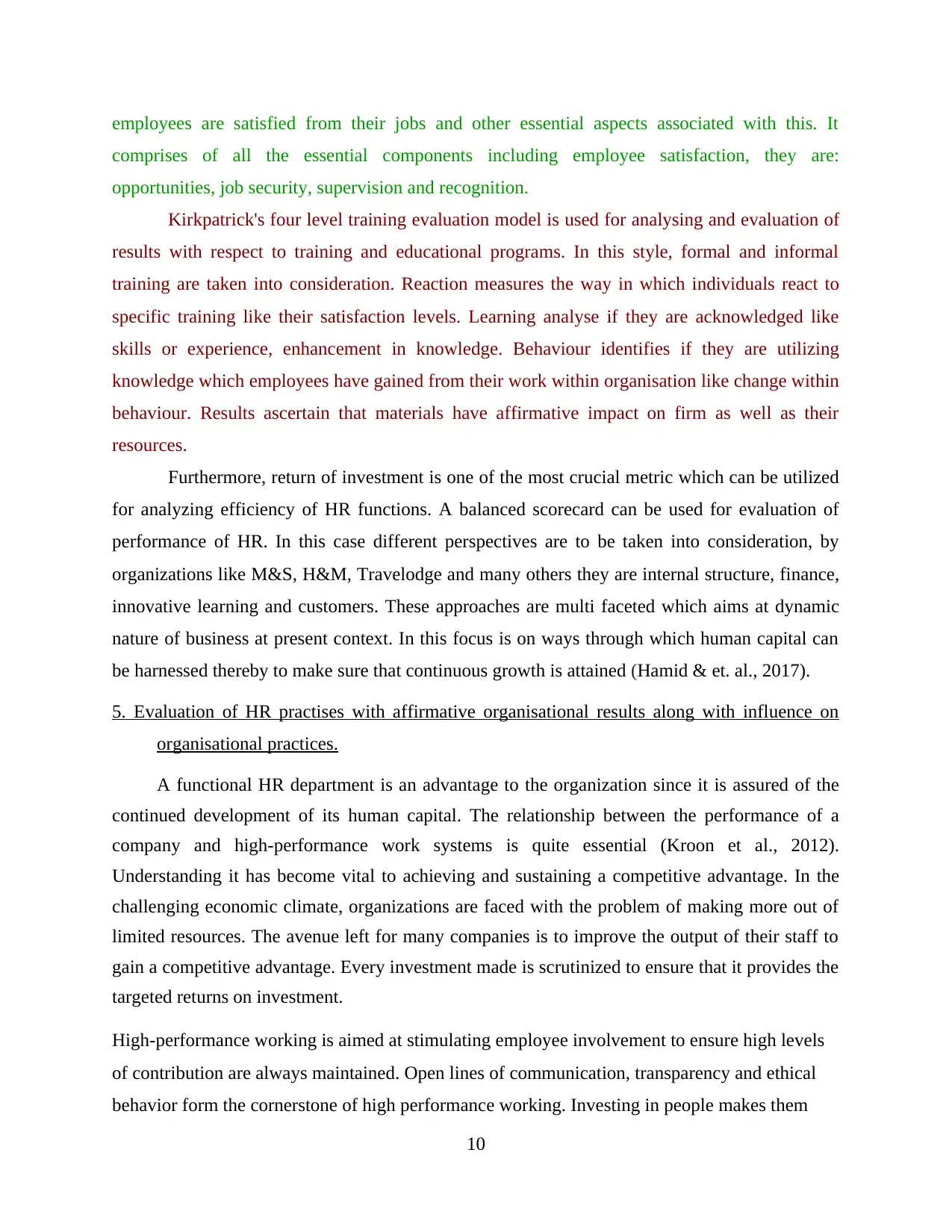
employees are satisfied from their jobs and other essential aspects associated with this. It
comprises of all the essential components including employee satisfaction, they are:
opportunities, job security, supervision and recognition.
Kirkpatrick's four level training evaluation model is used for analysing and evaluation of
results with respect to training and educational programs. In this style, formal and informal
training are taken into consideration. Reaction measures the way in which individuals react to
specific training like their satisfaction levels. Learning analyse if they are acknowledged like
skills or experience, enhancement in knowledge. Behaviour identifies if they are utilizing
knowledge which employees have gained from their work within organisation like change within
behaviour. Results ascertain that materials have affirmative impact on firm as well as their
resources.
Furthermore, return of investment is one of the most crucial metric which can be utilized
for analyzing efficiency of HR functions. A balanced scorecard can be used for evaluation of
performance of HR. In this case different perspectives are to be taken into consideration, by
organizations like M&S, H&M, Travelodge and many others they are internal structure, finance,
innovative learning and customers. These approaches are multi faceted which aims at dynamic
nature of business at present context. In this focus is on ways through which human capital can
be harnessed thereby to make sure that continuous growth is attained (Hamid & et. al., 2017).
5. Evaluation of HR practises with affirmative organisational results along with influence on
organisational practices.
A functional HR department is an advantage to the organization since it is assured of the
continued development of its human capital. The relationship between the performance of a
company and high-performance work systems is quite essential (Kroon et al., 2012).
Understanding it has become vital to achieving and sustaining a competitive advantage. In the
challenging economic climate, organizations are faced with the problem of making more out of
limited resources. The avenue left for many companies is to improve the output of their staff to
gain a competitive advantage. Every investment made is scrutinized to ensure that it provides the
targeted returns on investment.
High-performance working is aimed at stimulating employee involvement to ensure high levels
of contribution are always maintained. Open lines of communication, transparency and ethical
behavior form the cornerstone of high performance working. Investing in people makes them
10
comprises of all the essential components including employee satisfaction, they are:
opportunities, job security, supervision and recognition.
Kirkpatrick's four level training evaluation model is used for analysing and evaluation of
results with respect to training and educational programs. In this style, formal and informal
training are taken into consideration. Reaction measures the way in which individuals react to
specific training like their satisfaction levels. Learning analyse if they are acknowledged like
skills or experience, enhancement in knowledge. Behaviour identifies if they are utilizing
knowledge which employees have gained from their work within organisation like change within
behaviour. Results ascertain that materials have affirmative impact on firm as well as their
resources.
Furthermore, return of investment is one of the most crucial metric which can be utilized
for analyzing efficiency of HR functions. A balanced scorecard can be used for evaluation of
performance of HR. In this case different perspectives are to be taken into consideration, by
organizations like M&S, H&M, Travelodge and many others they are internal structure, finance,
innovative learning and customers. These approaches are multi faceted which aims at dynamic
nature of business at present context. In this focus is on ways through which human capital can
be harnessed thereby to make sure that continuous growth is attained (Hamid & et. al., 2017).
5. Evaluation of HR practises with affirmative organisational results along with influence on
organisational practices.
A functional HR department is an advantage to the organization since it is assured of the
continued development of its human capital. The relationship between the performance of a
company and high-performance work systems is quite essential (Kroon et al., 2012).
Understanding it has become vital to achieving and sustaining a competitive advantage. In the
challenging economic climate, organizations are faced with the problem of making more out of
limited resources. The avenue left for many companies is to improve the output of their staff to
gain a competitive advantage. Every investment made is scrutinized to ensure that it provides the
targeted returns on investment.
High-performance working is aimed at stimulating employee involvement to ensure high levels
of contribution are always maintained. Open lines of communication, transparency and ethical
behavior form the cornerstone of high performance working. Investing in people makes them
10
⊘ This is a preview!⊘
Do you want full access?
Subscribe today to unlock all pages.

Trusted by 1+ million students worldwide
1 out of 16
Related Documents
Your All-in-One AI-Powered Toolkit for Academic Success.
+13062052269
info@desklib.com
Available 24*7 on WhatsApp / Email
![[object Object]](/_next/static/media/star-bottom.7253800d.svg)
Unlock your academic potential
Copyright © 2020–2025 A2Z Services. All Rights Reserved. Developed and managed by ZUCOL.





